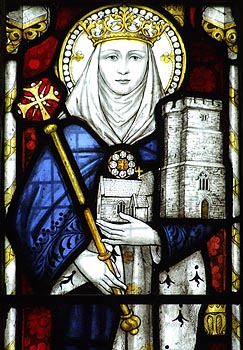 |
 |
|||
|
|
Princess Madrun was said to be the eldest daughter and heiress of King Vortimer Fendigaid (the Blessed) of Gwerthefyriwg (ByS) and therefore a granddaughter of the infamous King Vortigern of Britain. She was probably named after the Romano-British mother goddess, Matrona, before her family became full Christian (DNF). At a young age, Madrun married Prince Ynyr, who was tradtionally a descendant of the Emperor Magnus Maximus. Together they ruled the kingdom of Gwent after her father's death. Madrun appears in Welsh legend as one of those present at her ageing grandfather Vortigern's last stand at the hillfort of Tre'r Ceiri, above Llanaelhaearn in Lleyn, when he was attacked and defeated by the new King Ambrosius. She managed to escape with her young son, St. Ceidio, when the place was burnt to the ground and they fled to the nearby fortlet on Carn Fadrun, south of Morfa Nefyn. (LBS). Later, Madrun presumably returned to Gwent. However, an old story tells how, while on a return pilgrimage to Ynys Enlli (Bardsey Island), Madrun and her handmaid, St. Annun, stopped for the night at Trawsfynydd. Here they both had an identical dream in which they were commanded to build a nunnery where they slept. Amazed by the co-incidence, they did as required and the church there is dedicated to them still (Foulkes 1870). In later years, Queen Madrun apparently settled in Cornwall and was joined there by St. Ceidio. Together they evangelized the area around Minster, including building a church in the village near the royal Dumnonian summer palace at Tintagel. It was at Minster that she eventually died on 9th June some time in the late 5th or early 6th century and there she was buried. (Spencer 1991). Records of St. Madrun date back to the 13th century. She is generally considered legendary.
|
|||
| © Nash Ford Publishing 2006. All Rights Reserved. | ||||





 St. Madrun
St. Madrun